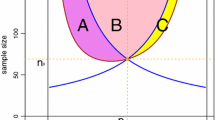Abstract
In this paper, we obtain fixed-width confidence interval for covariate-adjusted response-adaptive designs. Specifically, we consider logistic regression model and the normal regression model for binary and continuous responses, respectively, both in the situations for presence and absence of treatment–covariate interactions. Simulation study and real-data analysis are carried out.
Similar content being viewed by others
References
Anscombe, F. J. (1952). Large sample-theory of sequential estimation. Proceedings of the Cambridge Philosophical Society, 48, 600–607.
Atkinson, A. C., Biswas, A. (2005). Bayesian adaptive biased-coin designs for clinical trials with normal responses. Biometrics, 61, 118–125.
Atkinson, A. C., Biswas, A. (2014). Randomized response-adaptive designs in clinical trials. Boca Raton: Chapman & Hall/CRC.
Bandyopadhyay, U., Biswas, A. (1999). Allocation by randomized play-the-winner rule in the presence of prognostic factors. Sankhya Series B, 61, 397–412.
Bandyopadhyay, U., Biswas, A. (2001). Adaptive designs for normal responses with prognostic factors. Biometrika, 88, 409–419.
Bandyopadhyay, U., Biswas, A. (2015). Sequential and two-stage fixed-width confidence interval estimation in response-adaptive designs. Sequential Analysis (Special issue: Celebrating seventy years of Charles Stein’s 1945 seminal paper on two-stage sampling) 34, 350–363.
Biswas, A., Bhattacharya, R. (2016). Response-adaptive designs for continuous treatment responses in phase III clinical trials: A review. Statistical Methods in Medical Research. (In press).
Biswas, A., Coad, D. S. (2005). A general multi-treatment adaptive design for multivariate responses. Sequential Analysis, 24, 139–158.
Chang, Y.-C. I., Park, E. (2013). Sequential estimation for covariate-adjusted response-adaptive designs. Journal of the Korean Statistical Society, 42, 105–116.
Ghosh, M., Mukhopadhyay, N., Sen, P. K. (1997). Sequential estimation. New York: Wiley.
Hall, P., Heyde, C. C. (1980). Martingale limit theory and its application. New York: Academic Press.
McCullagh, P., Nelder, J. A. (1989). Generalized linear models (2nd ed.). London: Chapman and Hall/CRC.
Rosenberger, W. F., Stallard, N., Ivanova, A., Harper, C., Ricks, M. (2001). Optimal adaptive designs for binary response trials. Biometrics, 57, 909–913.
Sen, P. K. (1981). Sequential nonparametrics. New York: Wiley.
Tamura, R., Faries, D., Andersen, J., Heiligenstein, J. (1994). A case study of an adaptive clinical trial in the treatment of out-patients with depressive disorder. Journal of the American Statistical Association, 89, 768–776.
Wei, L. J., Durham, S. (1978). The randomized play-the-winner rule in medical trials. Journal of the American Statistical Association, 73, 838–843.
Zhang, L. X., Hu, F., Cheung, S. H., Chan, W. S. (2007). Asymptotic properties of covariate-adjusted adaptive designs. Annals of Statistics, 35, 1166–1182.
Acknowledgements
The authors wish to thank the Editor and one anonymous referee for their careful reading and constructive suggestions which led to some improvement over an earlier version of the manuscript.
Author information
Authors and Affiliations
Corresponding author
Appendix A
Appendix A
Result 7
As \(m\rightarrow \infty \),
almost surely, \(k=A,B\).
Proof
It is not difficult to observe that
where \({\widehat{\theta }}_i\) is the ML estimator based on \(\{\delta _{kj},Y_j,Z_j; j=1,2,\ldots ,i;k=A,B\}\), is a martingale sequence. Hence, applying the same technique as in (A.14) under Corollary 3.1 of Zhang et al. (2007), the required result follows. \(\square \)
Note 3
Note A.1. If \(\tau _k(\theta _k,Z)=1\), the above result implies
almost surely as \(m\rightarrow \infty \).
If \(\tau _k(\theta _k,Z)=\frac{\mathrm{e}^{\theta _k^\top Z}}{( 1+\mathrm{e}^{\theta _k^\top Z})^2}\), then the mean-value theorem yields
where M is described in Sect. 2. Consequently, (17) and (18) imply
almost surely. Hence, by the above result, it follows that
almost surely as \(m\rightarrow \infty \), \(k=A,B\).
Result 8
As \(\nu \rightarrow \infty \),
in distribution with \(\Sigma _k\) given in Result 1, \(k=A,B\).
Proof
Let \(\ell _k\), \(k=A,B\), be two r-component fixed vectors. Then, setting \(a_i=\ell _A^\top I_{ZA}^{-1}Z_i\) and \(b_i=\ell _B^\top I_{ZB}^{-1}Z_i\), consider
where \(\mu _k(Z_i)=p_k(Z_i)\) and \(\theta _k^\top Z_i\) for models (a) and (b), \(i=1,2,\ldots ,\nu \), \(k=A,B\). The sequences \(\left\{ V_{\nu i}, ~1\le i\le \nu , ~\nu \ge 1\right\} \) represent differences corresponding to the martingale sequence \(T_{\nu }=\sum _{i=1}^{\nu }V_{\nu i}\), \(\nu \ge 1\). Then, we get
Hence, by martingale central limit theorem (see, for example. Theorem 3.2 of Hall and Heyde 1980, p. 58), it will follow that
in distribution as \(\nu \rightarrow \infty \), where \(\eta ^2=\sum _{k=A,B}(\ell _k^\top \Sigma _k\ell _k)\), provided all the conditions of Theorem 3.2 in Hall and Heyde (1980) are satisfied. Here, all the conditions, except (3.19) of this theorem, are trivially satisfied. Now, to prove this non-trivial condition, write
where
Using Theorem 2.13 (iii) of Hall and Heyde (1980), we get, as \(\nu \rightarrow \infty \),
in probability, which implies
in probability as \(\nu \rightarrow \infty \). Hence, by the Cramer–Wold device, we get the required result. \(\square \)
About this article
Cite this article
Bandyopadhyay, U., Biswas, A. Fixed-width confidence interval for covariate-adjusted response-adaptive designs. Ann Inst Stat Math 70, 353–371 (2018). https://doi.org/10.1007/s10463-016-0596-3
Received:
Revised:
Published:
Issue Date:
DOI: https://doi.org/10.1007/s10463-016-0596-3




